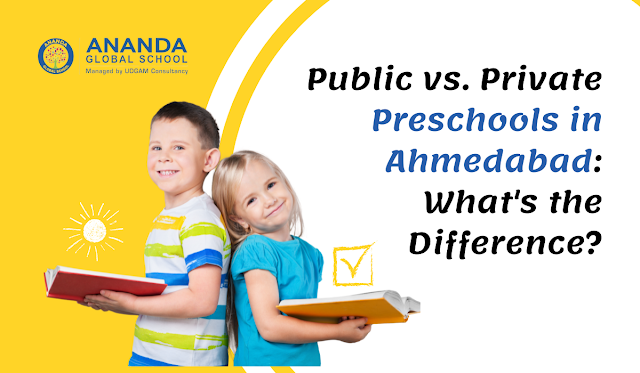Public vs. Private Preschools in Ahmedabad: What's the Difference?
Selecting the appropriate preschool for your child is an essential choice. In Ahmedabad, you have the option of public or private preschools, each offering a distinct learning environment. This blog post will explore the key differences between these two types of schools to help you make an informed choice.
Background Information:
Public Pre School in Ahmedabad are typically managed by the
government and follow a standardized curriculum. They offer a low cost option
for early childhood education. Private preschools, on the other hand, are
independent institutions with more flexibility in curriculum design and
teaching methods. Fees can vary widely depending on the school's offerings and
location.
Cost and Affordability:
Public preschools are significantly cheaper than private
ones. In many cases, public preschools are free or have minimal fees. Private
preschools can range from moderately priced to very expensive, depending on the
facilities and programs offered.
Curriculum and Educational Approach:
Public preschools typically follow a play-based curriculum
that emphasizes social development, language skills, and basic motor skills.
Private preschools may offer a wider variety of educational approaches,
including Montessori, Waldorf, or Reggio Emilia. Some private preschools may
also introduce academics at an earlier age.
Teacher Qualifications and Training:
Public preschool teachers are required to hold a teaching
degree and certification. Private preschools may have varying teacher
qualification requirements, although most will seek qualified and experienced
educators.
Facilities and Resources:
Public preschools may have limited resources and facilities
compared to private institutions. Private preschools can offer a wider range of
amenities, including playgrounds, libraries, computer labs, and specialized
learning spaces.
Class Size and Student Teacher Ratio:
Public preschool classes tend to be larger than private
ones. This can result in a higher student-teacher ratio in public schools,
potentially limiting individual attention for each child. Private preschools
often boast smaller class sizes and lower student-teacher ratios, allowing for
more focused learning.
Parental Involvement and Communication:
Public preschools may have less frequent communication with
parents compared to private institutions. Private preschools often encourage
active parental involvement through open houses, parent-teacher conferences,
and volunteer opportunities.
Performance and Outcomes:
There is limited data available on the comparative academic
performance of students from public and private preschools in Ahmedabad.
However, research suggests that high-quality preschool experiences can benefit
all children, regardless of the school type.
Cultural and Socioeconomic Diversity:
Public preschools typically reflect the broader community's
demographics, offering a more diverse learning environment. Private preschools
may vary in terms of diversity, depending on their location and admissions
policies.
Conclusion:
Ultimately, the best preschool for your child depends on
your individual needs and priorities. Consider factors like cost, curriculum,
class size, and parental involvement when making your decision. Both public and
private preschools in Ahmedabad can provide a valuable foundation for your child's
educational journey.




Comments